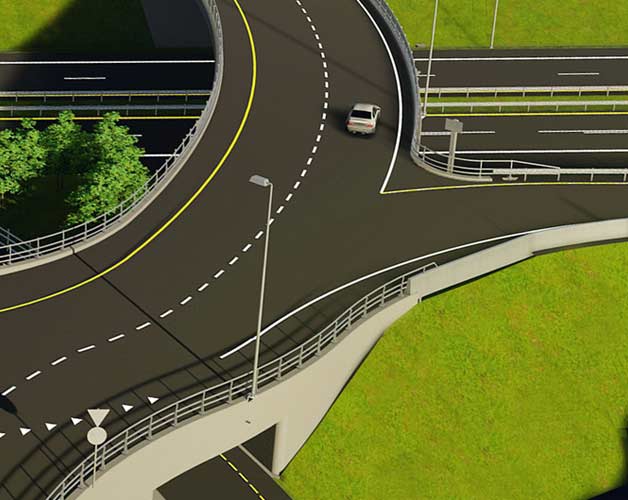IFC relevant also for infrastructure

The data model exchange standard IFC is becoming more and more applicable also for infrastructure projects. However, will several standards still be the standard?
By Johnny Jensen and Idar Kirkhorn, Vianova Systems AS
 Society loses billions
Society loses billions
Standardized data exchange formats are a must for different software to be able to interoperate optimally. With considerable inter-disciplinarity and often many different players involved, this applies not least for the software used to design, build and manage transport infrastructure.
Without an agreed-upon work process and data flow you cannot optimally plan, design and build quality infrastructure. Society loses billions of Euros due to errors, omissions and additional work caused by shortcomings in this respect.
Standardization is necessary
In other words; a standardization of data exchange interfaces is required. Moreover; in a world where the stakeholders increasingly are working across national borders, they must be international standards. The drawback is that international standardization work is slow and often lags behind the market forces. Therefore you see exchange interfaces often arise based on proprietary formats, sometimes even becoming de facto standards – in lack of industry-agreed ones.
The building industry however has managed to agree on IFC, a format originally defined for the data exchange of building information models (BIM). The format is today supported by most software tools in the building industry.
IFC is managed by buildingSMART International, formerly known as International Alliance for Interoperability (IAI). The format is now also an ISO standard (ISO 16739).
The infrastructure industry however is lacking a corresponding open international standard. Therefore, in spite of being a proprietary format, DWG is used by many due to the spread of AutoCAD. But the format is not well suited as an exchange format for BIM due to the fact that it does not provide a simple or uniform way to associate property data to the objects.
In other words there is a big demand for an open exchange format also for infrastructure models – a format that must be fundamentally based on object-oriented thinking, and of course handle attribute data in a logical manner.
IFC alignment a must
One of several challenges related to the use of IFC in infrastructure design (roads, railways, tunnels, bridges, etc.) is that these disciplines are based on reference lines – which fundamentally do not exist in IFC (buildings have their axis system). Hence, a basic representation of reference lines (IFC alignment) is required as basis for all linear infrastructure.
Much of this is now being taken care of through international standardization processes. Both builidingSMART and OGC (Open Geospatial Consortium) have work groups dealing with this. Actually we are requested these days to comment on proposals from both organisations, on how reference line information shall be exchanged.
Active participation
OGC is an international consortium of more than 500 companies, government agencies and universities, collaborating in standardization. Vianova Systems is one of several members from Scandinavia – participating actively in the technical committee.
OGC and buildingSMART have worked closely for a couple of years to arrive at a common conceptual model. This will mean, that even though the file formats are different, a reference line in an IFC file will have the same meaning and should be understood the same as a reference line in a GML file.
Difficult decision
When we in Vianova some 10 years ago started working on our new BIM tool generation Novapoint and Quadri we really had to look into the crystal ball to make a difficult choice. Which basic technology standard should we go for?
We ended up deciding for the ISO 19100 series of ISO TC 211, the spatial data standards that both SOSI, CityGML and the EU INSPIRE directive is based on. We have built up our new modelling kernel based on this.
In recent years however there has been more and more talk about IFC also for infrastructure. We have therefore had to answer questions like "Why can´t you save the road model in IFC?" And "Why do you have to use something else when IFC already exist?" There has been a lot of misunderstanding in the industry about this – and lack of competence.
Simply put: The reason is the ISO 19100 standards take into account that "the whole world" should be modelled as geodata – ranging from reindeer grazing land, cave interior refinements, to buildings. This in contrast to IFC, which from its origin clearly defined the scope of the standard, meaning that the information found outdoors is not covered. The ISO standard can hence to a greater extent tell what "the world" consists of, and how a model of "the world" looks.
Several standards ok
Today we are experiencing the situation somewhat differently. We see that IFC is slowly getting a position also within infrastructure, together with the ISO 19100 standard. Two standards are after all manageable. Think of all the file types we otherwise daily relate to.
We also recognize that most likely there will not be just one standard covering all needs for data exchange. A set of standards will exist also in the future.
We have now therefore taken the first important steps to support the IFC format in our infrastructure design tools. In December (2014) we had the pleasure of launching a new version of NovapointDCM with functionality for import and export of geo-referenced IFC objects.
We believe this is a practical start and good enough for quality control of the outdoor model aligning building bodies for example.
So far we convert the IFC data to the Quadri model, but we are really aiming at a conversion-less reading of IFC, and perhaps also other formats. This will mean that the Quadri model will be able to handle IFC objects simultaneously with objects defined by another standard, eg. SOSI or CityGML. The goal is to have auto-generation of IFC definitions in such a way that new versions of IFC will be imported into the system.
Practical standardization work
This plan was well received by Steen Sunesen, general manager of builidingSMART Norway, who in several ways head the standardization of Open BIM, also internationally. Following up on our involvement in OGC we had a meeting in November to discuss how Vianova Systems can participate closer in buildingSMART´s standardization work with IFC for infrastructure.
“Standardization work is really not about pursuing the ultimate solution. It´s about finding a good practical solution that everyone can stand behind, and that can be used for a long time”. This is Sunesen´s view.
We fully support such a view and look forward to a constructive and fruitful cooperation with both buildingSMART and OGC in the exciting times to come.